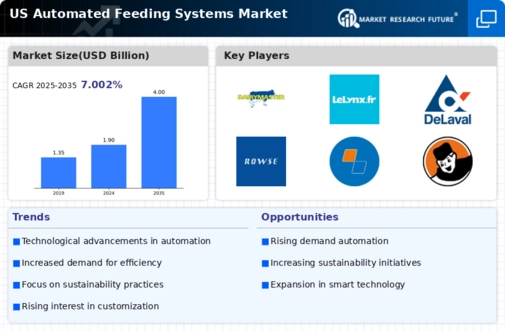The US Automated Feeding Systems Market is characterized by a variety of innovative technologies designed to optimize livestock feeding processes, catering primarily to dairy and other agricultural sectors. The competition within this market is driven by increased adoption of automation technologies aimed at enhancing operational efficiency, reducing labor costs, and improving the overall management of animal health and nutrition. Industry players are continuously seeking new advancements in technology, custom solutions, and improved functionalities to differentiate themselves and gain market share.
The presence of established players and emerging startups further intensifies the competition, leading to an environment ripe for collaborations, partnerships, and technological innovations that cater to the evolving demands of livestock operators across the United States.Dairy Master has established a significant market presence in the US Automated Feeding Systems Market by offering a broad range of solutions tailored to the needs of dairy farmers. The company focuses on delivering efficient feeding systems that enhance productivity and streamline operations.
Dairy Master's solutions are recognized for their high-quality design and adaptability to different farm requirements, providing significant strengths in optimizing feed usage and improving herd management. By continuously investing in research and development, Dairy Master remains at the forefront of technology advancements in the automated feeding sector and is well-positioned to leverage its expertise in the growing US market.Lely, a well-known entity in the agricultural technology space, has made substantial inroads into the US Automated Feeding Systems Market through its comprehensive suite of solutions that support modern dairy farming.
Lely's key products include advanced robotic feeding systems, advanced data management tools, and automation technologies designed to improve feeding efficiency and animal welfare. The company's strengths lie in its robust customer support and a long history of innovation in automation. Lely's commitment to sustainability and efficiency resonates well with the increasing demand for advanced agricultural solutions. Additionally, Lely has engaged in strategic mergers and acquisitions to expand its market presence and enhance its product offerings, ultimately solidifying its leadership position in the competitive landscape of the US automated feeding systems industry.





















Leave a Comment